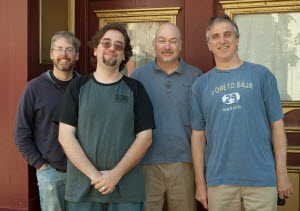Pitching Diablo
The creative freedom that influenced Diablo’s quests and bestiary extended beyond Condor’s walls. After a fortuitous meeting between Condor’s co-founders and Allen Adham, co-founder of Blizzard Entertainment, Allen agreed to publish Diablo. He loved the game’s gothic-horror setting and tone but expressed concerns over Diablo’s use of turn-based gameplay. Allen and his colleagues at Blizzard found Diablo’s “my turn, your turn” style of gameplay dull and archaic after the success of WarCraft, their real-time strategy game.
Allen’s insistence that Condor convert Diablo to a real-time game exploded into a passionate debate between the studios. After round after round of heated discussions, Brevik and the Schaefers decided to bring their team in on the dispute.
“Our open minds were our greatest advantage at that very early phase,” said Matt Uelmen, Diablo’s composer. “The thing to remember is that real-time wasn’t even in the picture for the computer RPGs we grew up on, like the roguelikes. So even though we could all recognize real-time as an inevitability, to be told ‘the future is here’ was still a little shocking.”
Overnight, Brevik, the game’s lead programmer, converted Diablo to real-time. From the moment he clicked on a skeleton and watched his Warrior march over and shatter the bony foe to dust, the appeal of instantaneous feedback clicked. Turn-based was out. Real-time was in.
Other arguments in favor of or opposed to various features rose up during Diablo’s development, leaving the cutting room floor littered with grand ideas. Early on, Condor proposed selling expansion disks for five bucks apiece. Each expansion would include new weapons, spells, dungeon tiles, and a collectible trading card depicting a rare item included on the expansion disk.
Eventually, the two Blizzards decided that trading cards and a constant stream of expansions were less important than other issues–namely, the construction of the free Battle.net gaming service and Diablo’s adult-oriented content.
“We didn’t think our vision took things too far,” Erich Schaefer said. “I remember one issue Max had with somebody down at Blizzard South”–a tongue-in-cheek nickname used by Blizzard North developers to reinforce their equality to Blizzard Entertainment when Entertainment tried to throw its weight around–“was when a guy asked, ‘Is this a game you would be proud to show your grandmother?” And Max’s answer was yes. But our answer was also that we weren’t making this for somebody’s grandma. We were making it for us.”
“You specifically want to go out and hire passionate, brilliant people, and passionate, brilliant people are opinionated,” explained Jeff Strain, a programmer at Blizzard Entertainment who helped build Battle.net before migrating to the StarCraft development team. “When you put four, five, or six people in the room together, all highly opinionated, it’s highly unlikely that, for any given subject, they’ll all have the same opinion. In this particular case, the problem was that chain of command was not clear. The person who was responsible for making the ultimate call was not very clearly specified, and that’s always a dangerous situation.”
More than impassioned arguments and creative freedom, the intimate size of the Diablo team meant that every developer’s personality left a footprint in the game’s DNA. Michio Okamura’s knowledge of Japanese culture and raw artistic talent populated Diablo’s dungeons with tough and frightening denizens such as the Butcher. Eric Sexton’s eagerness to flesh out the game’s mythology gave the Butcher a special place in Diablo and in the minds of every gamer who ventured down into the dark. Blizzard Entertainment’s more seasoned developers fought for the real-time, click-click-click gameplay that made Diablo such a joy to play, and were responsible for engineering Battle.net, which became the standard bearer for free gaming services. And still others such as Matt Uelmen, who composed Tristram’s iconic soundtrack that immediately springs to the mind of millions of gamers when they hear the word “Diablo,” left an indelible mark on the game.
Gamers and critics agreed. Over the course of its shelf life, Diablo went on to sell over 2.5 million copies and nabbed multiple Game of the Year awards following its release in late 1996. It also went on to become a giant ongoing franchise for Blizzard. The game’s sales figures and accolades exceeded Blizzard North’s wildest expectations, largely because they had not set out to make an award-winning product. They simply wanted to make a game they enjoyed playing—and, ideally, bring in enough money to keep the lights on.
“We had no project management or methods or agile development—all this fancy pants shit they have now,” David Brevik put it simply during one of the many times he and I reflected on the early days of Condor and Blizzard North. “Just guys on a shoestring budget and a prayer.”
Stay Awhile and Listen: How Two Blizzards Unleashed Diablo and Forged a Video-Game Empire is the first book in the Stay Awhile and Listen Series and will be available on Kindle, iTunes, and the Nook on Oct. 31.


